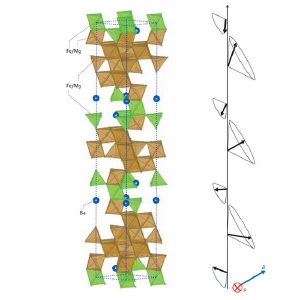Aug 22 2008
A rare class of materials, known as multiferroics, holds great promise for future applications, for example as data storage devices or sensors. However, progress has been hampered by the low operation temperatures and high magnetic fields required to control a property of the materials known as electric polarization. A solution to this problem may have been found by researchers from RIKEN's Advanced Science Institute in Wako and from the Japan Science and Technology Agency (JST), who have synthesized a multiferroic material in which electric polarization can be easily controlled by small magnetic fields.
 Multiferroic Ba2Mg2Fe12O22. The left panel shows the schematic crystal structure, and the right shows the corresponding magnetic moments. The magnetic moments show a periodic variation along the crystal axis, a so-called spin spiral. The spin spiral creates an electronic polarization P. As each individual magnetic moment rotates like a spinning top, small magnetic fields B significantly influence the spin spiral.
Multiferroic Ba2Mg2Fe12O22. The left panel shows the schematic crystal structure, and the right shows the corresponding magnetic moments. The magnetic moments show a periodic variation along the crystal axis, a so-called spin spiral. The spin spiral creates an electronic polarization P. As each individual magnetic moment rotates like a spinning top, small magnetic fields B significantly influence the spin spiral.
In a ferromagnetic material, the individual magnetic moments of its atoms are aligned in one direction. In a ferroelectric material, if the positive and negative electric charges are uniformly separated electric polarization is generated. In multiferroic materials, magnetism and ferroelectricity occur simultaneously and both properties are coupled to each other.
Hexaferrites, compounds based on iron oxide, comprise a particularly interesting class of multiferroic materials and hold promise as novel high-temperature multiferroics. “Hexaferrites at present may be the best candidates for room-temperature multiferroics, as at least their magnetism exists up to room-temperature,” comments team-member Shintaro Ishiwata.
In the journal Science1, the researchers now report low-magnetic-field control over the electric polarization in the hexaferrite Ba2Mg2Fe12O22. This compound is part of a class of multiferroics in which the ferroelectric polarization is generated by its unusual magnetic structure. The electric polarization is induced by so-called spin spirals, or cyclic variations in the orientation of the different magnetic moments along the crystal.
The conical spiral structure found in Ba2Mg2Fe12O22 is particularly interesting, as the magnetic moments additionally rotate around their axis like small spinning tops. Just as spinning tops can be easily pushed off balance by a horizontal force, a small external magnetic field can significantly alter the properties of the spin spiral. This strongly influences the electric polarization through the magnetoelectric coupling.
For conical spin spirals, the sensitivity of the magnetic moments to external fields is so strong that the ferroelectric polarization can be switched by magnetic fields that are almost two orders of magnitude lower than in other multiferroic compounds. “This provides an exciting avenue of exploring new multiferroic materials for novel electronic devices,” says Ishiwata. However, as this effect remains confined to relatively low temperatures of 50 K (-223.15 °C), the researchers now aim to develop multiferroic materials with similar properties for high-temperature operation, possibly up to room-temperature.
Reference
Ishiwata, S., Taguchi, Y., Murakawa, H., Onose, Y. & Tokura, Y. Low-magnetic-field control of electric polarization vector in a helimagnet. Science 319, 1643–1646 (2008).